Sure, being in the middle of a rock concert riot sounds like an exciting night. If nothing else, you’ll have a great story to tell later. Yet there’s also a chance you’ll later spend hours picking the glass splinters out of your hair from the rain of bottles being thrown at the stage. Or get maced, clubbed and/or arrested.
It’s amazing it doesn’t happen more often. You take a bunch of hormonally and chemically jacked-up teens and young adults, fill their heads with tunes exhorting freedom and revolution. Then add certain bands trading on a wild, dangerous image to the mix….
Here, in chronological order, are 10 shows that ended badly, some before they could even start. Before you start furiously commenting, “Hey, where’s Altamont? I’ve seen Gimme Shelter!” or “What about The Who in Cincinnati? People died, man!” there is one parameter to this list: No onsite deaths. That eliminates both Altamont and Cincinnati. (Also, neither event ended the concert.)
Sadly, these 10 are hardly the only rock concert riots, but certainly among the most entertaining.
The Doors
New Haven Arena, New Haven, CT
December 9, 1967
Here’s one more accolade you can posthumously give Jim Morrison: he was the first rock star to be arrested onstage. He was probably also the first rock star to be maced backstage at his own show, but no one keeps records for that.
While the opening acts played, Morrison and a young woman had slipped into a bathroom shower stall for some privacy. A policeman working backstage security came across them, and thinking the lead singer of the headlining act for an interloper, told them to “Beat it.” Morrison grabbed his crotch and told the cop to “Eat it.” The policeman pulled out a can of mace and said, “Last chance to beat it.” The Lizard King’s response: “Last chance to eat it.” The cop maced him.
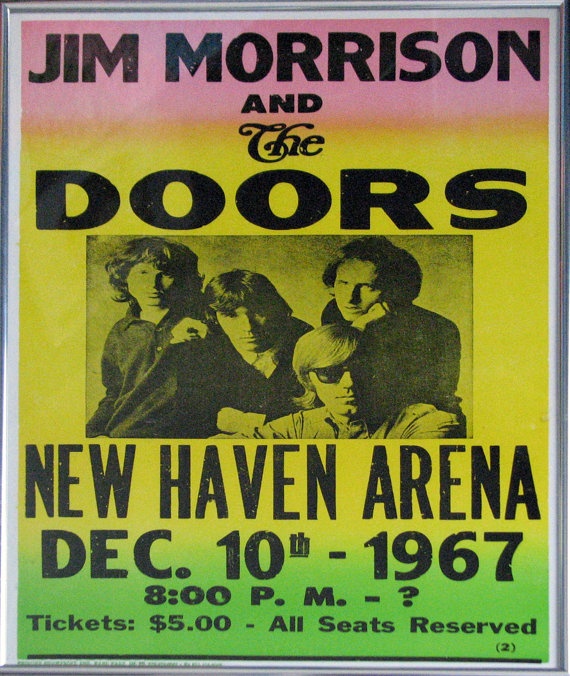 The show was delayed for an hour while Morrison’s eyes were washed out. As the band took the stage there was a line of police at the front of the stage. The show proceeded normally until they launched into “Back Door Man.” According to Doors keyboard player Ray Manzarek, instead of Morrison bellowing the opening “Oh yeah! All right!” Morrison started to tell the story of what had happened to him backstage in what’s been described as an “an obscenity-laced tirade.”
The show was delayed for an hour while Morrison’s eyes were washed out. As the band took the stage there was a line of police at the front of the stage. The show proceeded normally until they launched into “Back Door Man.” According to Doors keyboard player Ray Manzarek, instead of Morrison bellowing the opening “Oh yeah! All right!” Morrison started to tell the story of what had happened to him backstage in what’s been described as an “an obscenity-laced tirade.”
The house lights came on. Police came onto the stage, took the microphone from Morrison – one of them saying into the mike: “You’ve gone too far, young man” – and arrested him, and announced that the show was over.
Morrison was charged with obscenity and inciting a riot, but the charges were later dropped. The incident inspired the later Doors song “Peace Frog.”
Sly and the Family Stone
Grant Park, Chicago, IL
July 27, 1970
Some performers have carved out such a reputation for flakiness that the “will they/won’t they” tension becomes part of their appeal. By 1970, Sly Stone had taken this to new heights, missing more than half of his concerts. He had already burned Chicago with three cancelled shows, so a free concert in downtown’s Grant Park was scheduled to make up for disappointing his Windy City fans. Alas, his reputation preceded him.
People started gathering at 7 a.m. for the concert slated to begin at 4 p.m. When the first opening act, Fat Water, took the stage, people began shouting, “We want Sly!” Rumors began to circulate that the headliner wasn’t going to show. After Fat Water’s three songs the Flying Burrito Brothers prepared to take the stage… until a bottle was thrown from the crowd. It was quickly followed by a hail of debris: bottles, cans, stones and broken-off pieces of concrete and park benches. Thousands of concertgoers started to rampage through the park, pelting police with an even-heavier flow of bottles and stones. The cops responded by beating people with nightsticks. Cars were smashed, overturned and set on fire.
The violent conflict soon spread into The Loop, with gangs of rioters breaking the show windows of pricey stores and looting their contents. The melee didn’t subside until 10 p.m. that evening. The final toll: 162 people injured, 126 of them police officers. Another 160 were arrested. Three people were shot, but it was unclear who pulled the triggers.
The title of Sly’s album the next year? There’s A Riot Goin’ On.
Jethro Tull
Red Rocks Amphitheater, Morrison, CO
June 10, 1971
The rule of unintended consequences came into play at what became known as “The Riot at Red Rocks.” Some 1,000 to 2,000 people arrived to the sold-out show without tickets. Police directed them to an area just off the parking lot where they could hear but not see the concert.
But after opener Livingston Taylor went on, some of the freeloaders weren’t happy with the arrangements. They threw stones at and rushed the line of police guarding gates into the venue. Others tried to scale the walls around the amphitheater.
During the melee, tear gas was dropped on the attackers from a dangerously low-flying helicopter. It incensed the rioters further. Wind drifted the gas into the theater. Taylor left the stage, but Ian Anderson and his Jethro Tull bandmates later gamely came on. After the first song, the singer/flutist quipped, “Welcome to World War III.” He saved the evening by calming the crowd and instructing them to cover their mouths with pieces of clothing. As the fracas continued outside and more tear gas was dropped, Tull continued to play, likely preventing a bad situation from becoming worse.
For the next five years only soft-rock bands were allowed to play Red Rocks.
Eric Clapton
Roosevelt Stadium, Jersey City, NJ
July 7, 1974
 It should have been a triumphant moment in Eric Clapton’s comeback after reportedly kicking his heroin habit. He was riding high with the just-released 461 Ocean Boulevard getting a positive initial reception. Its first single, a cover of Bob Marley’s “I Shot the Sheriff,” was climbing the Hot 100 chart toward scoring Clapton his first #1. But the Jersey City stop of the tour at a dilapidated, rusting minor league ballpark was a black mark.
It should have been a triumphant moment in Eric Clapton’s comeback after reportedly kicking his heroin habit. He was riding high with the just-released 461 Ocean Boulevard getting a positive initial reception. Its first single, a cover of Bob Marley’s “I Shot the Sheriff,” was climbing the Hot 100 chart toward scoring Clapton his first #1. But the Jersey City stop of the tour at a dilapidated, rusting minor league ballpark was a black mark.
Looking distracted and undernourished, Clapton was in no shape to be on that stage. He not only forgot the lyrics but the guitar riff for “Layla.” Even when Freddie King joined him onstage, it couldn’t rouse the listless (and some believe drunk or still drugged-out) Clapton. Some of the audience began booing. After about 35 minutes, the star was mercifully led off the stage.
Some 50,000 people had shown up to see God and, frankly, God sucked that night. Some showed their displeasure in more active fashion by breaking through the barriers behind the stage and surrounding Clapton’s limo to prevent him from leaving. As people streamed down from the stands, some disgruntled fans broke up the wooden seats and jumped into the infield. More than a few brought fireworks, which they hoped to set off in a celebration at the end of the show. Instead they used them as weapons.
Two days later at the Montreal Forum, an apparently cleaner and more engaged Clapton played a much more successful show.
Led Zeppelin
Tampa Stadium, Tampa, Florida
June 3, 1977
The tickets said “rain or shine,” and you’d think that Jimmy Page would have been able to invoke his deal with the devil to keep the clouds away… but it was not to be. Around 15 minutes into the show, a thunderstorm rolled in. After a truncated version of “Nobody’s Fault But Mine,” Zeppelin left the stage for what Plant told the crowd would be a 15-minute break.
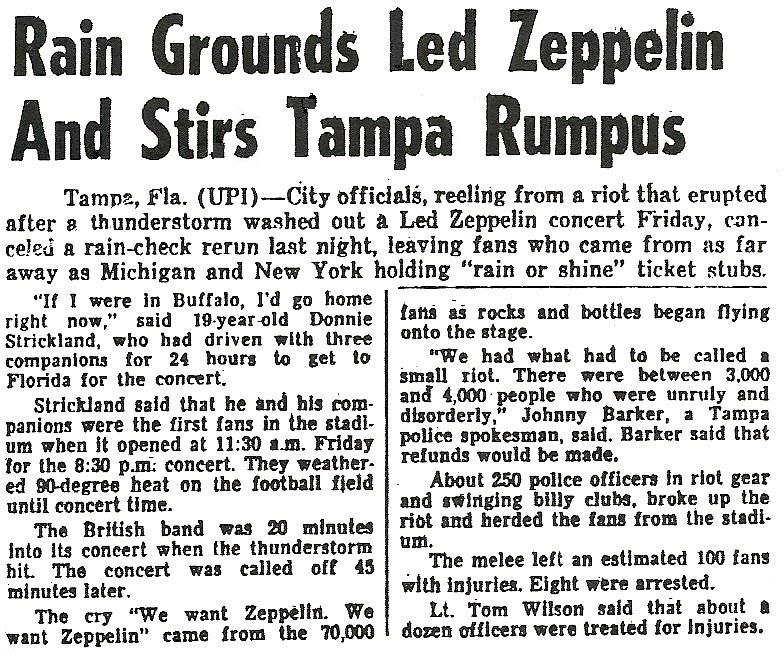 Many of the 70,000 fans in the audience had already hung out for hours since doors opened at 11:30 a.m. in the brutal Florida summer heat. Then they waited another 45 minutes to be told the band would not be returning.
Many of the 70,000 fans in the audience had already hung out for hours since doors opened at 11:30 a.m. in the brutal Florida summer heat. Then they waited another 45 minutes to be told the band would not be returning.
The audience did not take the news well. Amidst chants of “We want Zeppelin,” bottles, cans, stones and even shoes were thrown at the stage. A few thousand rushed the barricade in front of the stage. Some 250 cops in riot gear repelled them and then began to herd unruly fans out of the stadium.
The final toll was 100 concertgoers injured, and eight people were arrested.
Related: Listings for 100s of classic rock tours
Public Image, Ltd.
The Ritz, New York, NY
May 15, 1981
By 1981, it was hard to think of PiL as a band. Drummer Martyn Atkins was gone, and Jah Wobble, whose untutored, dub-wise bass was one of their most distinctive musical elements of a band whose music specialized in being abrasive, had been read out of the band over “corporate espionage.” Public Image was now John Lydon – formerly known as Johnny Rotten, lead singer of The Sex Pistols – plus guitarist Keith Levene, and Jeanette Lee, who was not a musician but videographer; they were a company, not a band. And had recently moved from London to New York City, setting themselves up in a midtown Manhattan loft.
Instead of a concert, PiL decided to stage a piece of performance art. They would perform behind the Ritz’s giant video screen that usually was lowered at the front of the stage in between sets to show music videos (all the rage at the time), and then raised just before the bands came onstage.
When the show finally began well past midnight, a bank of spotlights along back wall facing the screen threw elongated silhouettes onto it. At the same time, Lee wandered the stage with a video camera that fed images projected onto the screen. It looked great, but no one had bothered to inform the crowd – who had waited for hours outside in the rain, expecting a rock show – what they would be seeing.
What they got was a bucket of noise: Levene wanking around, an older tuxedoed drummer recruited from the union hiring hall playing a jazzy groove, and Lydon abusing the crowd from behind the screen.
“Getting your money’s worth, New York? This is rock ‘n’ roll!” he sneered, his visage projected 30-feet high onto the screen like some snotty Big Brother.
“You’re all a bunch of fucking hippies, into peace and love!”
“You’re just boring Americans,” he howled. “Why don’t you do something?”
A beer bottle flew out from the crowd towards the stage. Then another. And another.
“Don’t like the screen?” Tear it down!”
A few more bottles sailed towards the screen. Following Lydon’s orders, fans at the front of the stage started clambering onto it, reaching for the video screen. House security bruisers rushed over to shove them back onto the floor. For the audience, the fun was just beginning as others also decided to bum rush the stage.
If you’re a new Best Classic Bands reader, we’d be grateful if you would Like our Facebook page and/or bookmark our Home page.
Levene even came out from behind the screen to try to calm things down, but only became a target, and was dragged off the stage by security. At that moment, the plug was pulled, a harried voice came over the PA, shouting, “Show’s over,” and the house lights came on. Ironically, as the melee ensued on the auditorium floor, concertgoers upstairs in the balcony sat safely at their tables watching from above what had indeed become a highly entertaining piece of auto-destructive performance art. They waited for the fracas to play itself out, and once the coast was clear came down the stairs. The entire auditorium dance floor was covered in small shards of broken beer-bottle glass.
The next weekend, Ritz bartenders were pouring beers into plastic cups before serving them to customers.
Guns N’ Roses
Riverport Amphitheater, Maryland Heights, MO
July 2, 1991
For the first 14 songs of this show outside St. Louis, it seemed like one of Guns N’ Roses’ less notorious performances on the massive Use Your Illusion tour. Axl Rose had shown up, the show started at a reasonable hour, and everyone was enjoying themselves.
Then, during “Rocket Queen,” the frontman saw a fan with a camera in the audience. This did not please him, and he pointed the fan out from the stage. When security did not respond quickly enough, Rose literally took matters into his own hands, jumping off stage, tackling the guy, taking his camera, and proceeded to make his way back to the stage, leaving punched out fans and security in his wake. Once back on stage, he announced he was leaving, slammed his microphone on the stage and stalked off. The band followed. It was now the crowd’s turn to get angry, and they did.
The post-show scene was a comedy of errors. Once the crowd realized the band was not coming back, they stared pelting the stage with beer cups. When they didn’t make it to the stage, members of Gn’R’s stage crew started taunting the crowd, which only made them angrier. In addition, Rose had jumped into the middle of the Saddle Tramps, a local motorcycle gang, and they made their displeasure known by beating up fans who were in their vicinity.
When the cops arrived, their presence only further riled up the mob.
Final tally: 60 people were hospitalized and 15 arrested. Charges were filed against Rose for inciting a riot which a judge later threw out, saying he wasn’t responsible for the incident. (See our On This Day item on this incident here.)
Grateful Dead
Deer Creek Music Center, Noblesville, IN
July 2, 1995
It’s one of those cosmic jokes: The Dead was at their most popular when they were declining as a live act. And for once, the people who claimed the newbies were ruining everything were right.
Inauspicious portents had already plagued the band’s summer 1995 tour when a lightning strike killed three fans about a week earlier outside RFK Stadium in Washington, D.C.
The latter-day Deadheads camping outside this sold-out show decided there was no good reason why they should experience the music from the parking lot even though they didn’t have tickets. So some 3,000 or so of them jumped over and tore down a fence at the perimeter, and raced into the crowd, brandishing pieces of wood, and swatting at anyone who crossed their path, be it other fans, the Dead’s security detail or the cops, who tried to beat the mob back with tear gas. While only 17 were arrested, the collective ethos of the Dead and Deadheads took a hard hit.
The band did manage to play a full show (some fans reported that Jerry Garcia seemed “out of it”). A planned second concert the next night at the venue was canceled. The Dead issued an open letter, headlined “This Darkness Got To Give” (the refrain from their post-Altamont commentary “New Speedway Boogie”). Calling the crashers “fools” and “saboteurs,” they admonished their fans, reminding them that the Dead is about “higher consciousness, not drunken stupidity,” and warning that “the spirit of the Grateful Dead is at stake.” Garcia died about a month later.
Woodstock 99
Griffiss Air Force Base, Rome, NY
July 22-25, 1999
What could go wrong? Five years earlier at Woodstock ’94, a 25th anniversary salute commemorating the original 1969 fest held on a farm near Saugerties, N.Y., in the Hudson River Valley, echoes of the past had descended with, first, heavy rains to make the site a mud bath. It drew 350,000 people for three days of music, and before its end security had given up on checking the tickets of the hordes streaming in and out the gates.
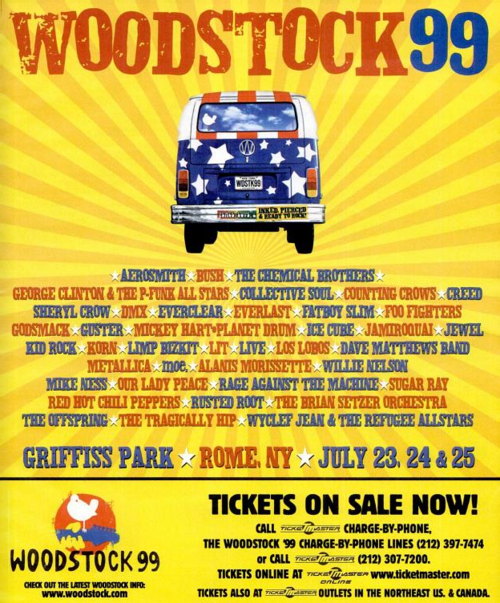 The 30th anniversary event sullied the Woodstock legend even further, first by being rife with corporate sponsors like MTV, which broadcast from the fest. Then there was the choice of venue, a real head-scratcher: a decommissioned air base with the stages set up on its tarmac runways that only reflected the weekend’s triple-digit heat back up on the concertgoers. And almost no natural shade to be found.
The 30th anniversary event sullied the Woodstock legend even further, first by being rife with corporate sponsors like MTV, which broadcast from the fest. Then there was the choice of venue, a real head-scratcher: a decommissioned air base with the stages set up on its tarmac runways that only reflected the weekend’s triple-digit heat back up on the concertgoers. And almost no natural shade to be found.
Add to that insufficient bathroom facilities. Twelve dollar pizzas and $4 bottles of water. Long lines for everything.
Then you force people to suffer through Limp Bizkit. Is it any wonder the crowd erupted?
At first the third iteration of Woodstock that drew some 200,000-plus fans was thought to be a success: no gatecrashers nor rain, though the high-priced passes ($150) sparked a brisk trade in counterfeits. And the horndog cries for women to show their breasts signaled sordid instincts throughout the gathering.
Then on Saturday night, noted philosopher Fred Durst growled his song “Break Stuff.” And that’s just what some in the crowd decided to do, pulling plywood off the perimeter fences and nearby structures. Observers reported that a woman was pulled into the moshpit near the front of the stage and gang-raped.
The next day a peace organization distributed candles to be lit in a demonstration of solidarity that evening. Instead, during a final set on one of the two main stages by the Red Hot Chili Peppers, they were used to start bonfires. An audio tower also caught fire.
Then as the final song of their encore, the Chili Peppers unwisely chose to perform a Jimi Hendrix tribute by playing his song “Fire.” A rampage across the site began that resulted in the burning of 12 trailers and other vehicles, looted and burned vendor booths, and ATMs being smashed to get at the cash inside. Riot police were finally called in to clear the site.
The aftermath: eight women were allegedly raped or molested (only one person arrested). A concertgoer who collapsed on the second night died in a hospital on the following Monday. Several lawsuits were filed against the promoters.
Despite all that, a two-CD set of live recordings from the fest, Woodstock 1999, was released in October. The following March a DVD of performances and interviews with artists and fans, Woodstock 99, hit stores. The “show” must go on.
- Brian Wilson’s ‘Pet Sounds’ Shines at 50th Concert: 2016 - 06/12/2025
- An Interview With Creedence Members Stu Cook and Doug Clifford - 04/25/2025
- The Sprawling ‘London Calling’ From The Clash - 01/14/2025

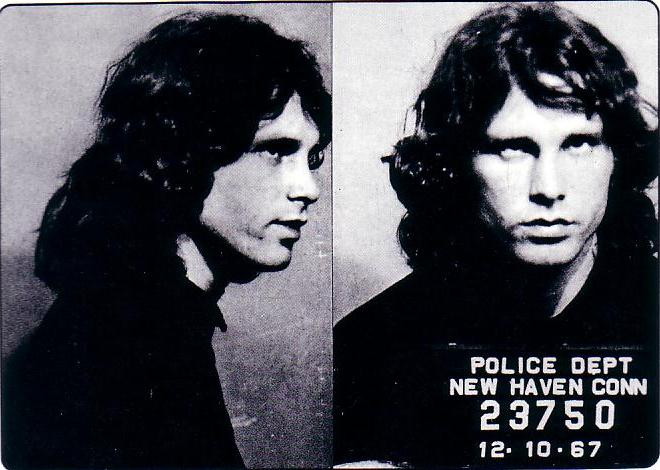
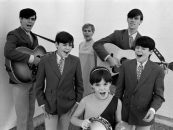


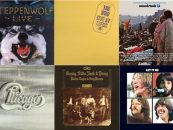

9 Comments so far
Jump into a conversationThe Doors tune “Peace Frog” wasn’t inspired by the New Haven concert. It was based on a poem Morrison wrote called “Abortion Stories”…
You forgot Newport Jazz. 68,or 69? That was a nice cock-up.
I went to Newport Folk. The fall after Newport Jazz which was in the spring of that year. What weird vibes. They had barricade fences up everywhere. Ah, the good old days.
That’s not what happened to Morrison. He was unknowingly in the dressing room of the opening band, Tommy & The Rivieras. They wore matching outfits with no pockets. They left their wallets, catered food, clothing in their dressing room. Jim was reported, not knowing who he was. The end of the story above is true if you jump past this, & repeated verbal exchanges. Maced & couldn’t see well upon taking stage & angry, rightfully so. After being arrested on stage, he was beaten and kicked on the floor by police. 3 media outlets filmed it. The film was ripped out of their cameras & they were arrested for disturbing the peace. Jim was strip searched once or twice in front of others to humiliate him. One arrested worked for Life Magazine, who was none too happy about this.All charges dropped. Jim was friendly with police. He was friends with the Chief Of Police in L.A. He did have an issue with authorities who took advantage of their positions. Las Vegas arrest included a charge of vagrancy? All was fine after Miami. Shared a beer with cops, paid one for his cap thrown into audience. He never “whipped it out” He was drunk & disorderly. ONE person, daughter of policeman said he did & recanted statement. Fugitive from justice, when not arrested? A sham. Judge Goodman wanted enormous payment. Still in negotiations when Jim died. Judge thrown off bench for accepting bribes (not from Morrison case) Morrison pardoned post-humously.
What about Spinal Tap’s infamous gig at Springfield (April 23, 1992)
Clash White Riot + Ramones fans twice destroyed seats London’s Rainbow Theatre.
Steve Dahl’s Disco Demolition Night in Chicago 1979 might be one.
Also, The Doors the Thursday after election night 1968 in Phoenix.
New Barbarians, 29 April 79, Milwaukee
81 arrested, chairs burned
I was at the Zeppelin show in Tampa. We were not happy when they walked off and didn’t come back.